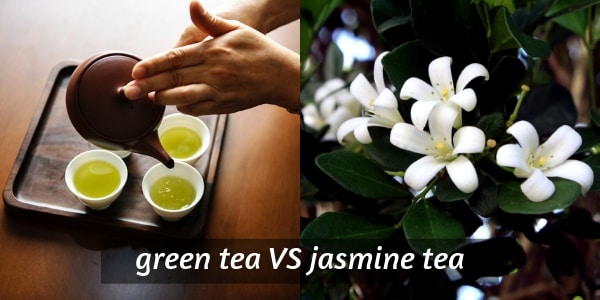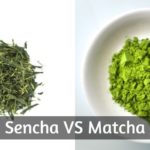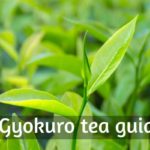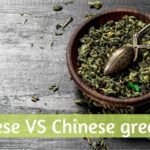When browsing in a tea shop, you'll often find green tea and jasmine green tea. Jasmine seems to be a very popular and traditional blend for tea, especially for the Chinese teas.
But what's the difference between green tea and jasmine tea ? How is jasmine tea better or tastier ? And why is it more expensive ?
As it turns out, there are some important differences between the two. So let's check out some key differences between green tea vs jasmine tea.

Table of Contents
1. Jasmine tea is friendlier for beginners
If you've got a newcomer to tea on your hands, offering them jasmine tea is a much friendlier option than green tea. This is because jasmine tea is so heavily scented with the beautiful flowers that it will mask the taste of green tea.
Green tea will still shine through a bit, but it will be much more bearable than regular green tea.
Also give the fact that many people are used to very strong tasting beverages, starting their foray into tea land with jasmine tea will seem kind of familiar.
Jasmine tea is strong tea, in that the jasmine is sometimes overpowering and that can be very comforting to one who is used to soft drinks and overly flavored lattes.
If the newcomer wanted to, they could add honey or sugar to their jasmine tea and make it even more delectable. To be fair though, jasmine tea can be drunk with no sweetener but it's not easy to enjoy if you don't have a well developed palate.
2. Green tea is only green, jasmine tea is any kind
Green tea comes in many forms, including Matcha, and blended green teas. The base is always green tea, though.
Jasmine tea however is not always green tea. It's most often green tea, yes, and even in those cases it's referred to as jasmine tea most commonly.
However jasmine tea can be any kind of tea from the Camellia sinensis plant. Meaning that green tea blended with jasmine flowers is the most common version, but not the only one.
Finding white tea with jasmine, and black tea with jasmine, and even oolong tea with jasmine is not uncommon.
White tea infused with jasmine flowers will have an even more delicate taste, and will be extra flowery. White tea is flowery enough on its own, and the jasmine seems to make it almost noble, so fine it tastes.
Black tea is a malty, stronger taste, and jasmine here will lift the brew and make it a bit airier, more delicate. It will cut through the malty, earthy taste and make the humble black tea a more sophisticated version.
As for oolong jasmine tea, Jasmine Pearls are famous enough on their own. These are small balls of tea, usually with two buds and one leaf, which have been rolled by hand into the shape of a pea-sized ball.
While brewing, this tea will unfurl and release the jasmine flavor. This is a greener, lighter oolong usually.
3. Jasmine tea is often tasty enough, needing no sugar
As noted a few paragraphs above, jasmine tea is very perfumed and beautifully scented. So much so that often you don't really need to add any sugar or honey, or any other sweeteners to this brew. (Check this article about teas that don't need sugar to taste great)
It's actually on my list of tea types that taste good with no sweeteners.
And when you're new to teas, especially the green and black and white teas, easing yourself into them with something like jasmine tea is going to be easier.
It's also a great way to start drinking tea with little or no sugar at all, if you're so inclined.
With green tea though, adding no sugar can be a bit of a feat. Often the taste of pure green tea is astringent and green enough that most people feel the need to take the edge off with at least a bit of honey.
This will take away from the majesty of green tea as a drink, so getting used to green tea with no sugar requires more willpower than jasmine tea with no sugar.
4. Green tea is a bit cheaper than jasmine tea
Pure green tea, as in a Sencha, is a bit cheaper than jasmine tea. For the purest, cleanest, greenest tea you'll pay a nice price but get a very beautiful tea.
Only the best leaves are used for pure green tea. For Matcha, those leaves are processed in such a way as to provide you with the best flavor, and the freshest leaves.
With jasmine tea, lesser leaves are used. Lower grade tea leaves will reduce the overall cost of making jasmine tea, without impacting the final flavor too much.
Even so, jasmine tea is often a little pricier than regular green tea, made of better leaves.
This is because the growing and picking of jasmine flowers is a laborious and expensive process, and kind of a dying industry as well.
Many jasmine teas are flavored artificially, and not with the true jasmine flowers. The cost of production is reduced even more.
But true jasmine tea, made of actual jasmine leaves blended with green tea, is going to be more expensive.
This is because the process requires many steps, is done over the span of several days, and a fresh batch of jasmine flowers is needed every day. That's a lot of flowers.
More on how jasmine tea is made you'll find in a few paragraphs, when we discuss it.
For now, know that if you were to compare a pure green tea, with no other flavorings, with a jasmine green tea, the jasmine tea would be a bit more expensive.
(If you like this article so far, you can pin it to your Pinterest board by clicking the image below. The article continues after the image.)
Jasmine tea is regular tea, infused with jasmine
As for how jasmine tea is made, let's all agree that it can be other types, not just green tea. So you will find white, black, and oolong jasmine tea, aside from green tea.
It's just that green tea goes best with jasmine, with white tea being a close second.
Usually in your tea, of any kind, you'll find just tea leaves. Sometimes you'll find flower petals or bits of dried fruit, if it's a blended tea. Doesn't matter if it's a white or black or green tea.
But with jasmine tea, you'll find no such thing in your tea leaves.
This is because the leaves of the tea plant are harvested, and dried, and then laid out in a layer. A layer of jasmine flowers is laid out on top of the tea layer.
The jasmine flowers are in a muslin bag usually, to allow the flowers to breather through the bag and release their scent onto the tea leaves.
The another layer of tea leaves is added on top of the jasmine flowers. And another layer of flowers. And then another layer of tea, and so on until everything is packed.
This happens only at night, because jasmine flowers bloom only at night.
So in the early morning of each day when the jasmine is in season, the flowers are picked and places in the muslin bags. They're kept in a cool place until the night falls, and the they're arranged in the layers of tea.
If you were to use the same bag of jasmine flowers the following night, you'd get a poor tea because the flowers have started to decay and have lost much of their scent.
It usually takes the tea leaves about 4 hours to absorb the jasmine scent. They also absorb the moisture of the jasmine flowers, so they have to be dried, again.
For the best results, and at least decent jasmine tea, the leaves must be scented at least 3 times. Premium jasmine teas are scented 6 times, and each scenting past that point only increases the price.
So according to how many times the tea leaves were scented, the final tea might be expensive or very expensive.
Why there are no jasmine flowers in jasmine tea
You might be wondering why there aren't any jasmine flowers in your tea. Well, aside from the jasmine flowers withering and losing their scent after a few hours, there is another point.
Of course, the flowers could be stripped of their petals, dried, and then blended with the tea just for appearance, even if they produced no extra flavor.
This would result in an even more expensive tea. Remember that growing jasmine flowers is a bit of a dying industry. They're not as much in demand, and wherever they are used they're considered premium items.
Adding dried jasmine flowers to your tea is going to take even more time, and cost more.
Aside from all this, it's simply not the original, traditional recipe for jasmine tea.
And as you've probably noticed, tea is a very traditional, ritualistic drink. Many customs and old habits are attached to tea drinking, and making jasmine tea this way is one of those things.
There are other teas, made entirely of jasmine flowers. Those are fairly rare, and their taste is different than the jasmine infused tea we know today.
Health benefits of jasmine infused tea
Now let's see if jasmine tea has any extra health benefits.
Sorry to disappoint here, if you were expecting a long list of ailments and aches that jasmine scented tea helps with.
But the thing is, jasmine infused tea is only as healthy as the tea used as a base. So if you have a green jasmine tea, you're getting the benefits of green tea.
Same goes for black tea, or white tea, or oolong tea.
Why scent the tea with jasmine, then ? Well, mostly for the novelty of it.
It also turns out that it's easier to drink jasmine tea than regular, plain tea because of the enticing scent. Jasmine scent has also enjoyed a long career in relaxation and easing the mind, so a jasmine scented might be just the thing for an anxious person.
If you're wondering about the caffeine in the base tea, don't worry. The way caffeine works in tea is different than with coffee. In tea, the L-theanine binds with the caffeine and produces a milder, slower releasing effect.
So you don't get as sudden a jolt of energy, or even those jittery moments as when you drink an espresso or a strong cup of filter coffee.
You will get energy and feel awake, yes, but it will be much gentler.
Even so, try to not drink too much jasmine tea. This is because the base tea used, especially if it's a green tea, will be a bit acidic and this can cause discomfort in the intestines and stomach if you drink too much of it.
Think about it. Would you drink 4 cups of plain green tea in a day ? Four cups of jasmine green tea will do the exact same thing, but your taste buds will be fooled.
An example of jasmine tea
Since we've been talking about jasmine tea this, and jasmine tea that, let's look at an example of jasmine tea. This one is a jasmine green tea, so it will be rather astringent and not as delicate as a white tea.
Green tea is the most common tea to pair with jasmine, so this means your tea will be a very well made one. There is tradition and skill behind this kind of tea, and it shows.
For one, this tea has a few jasmine flowers right in there with the leaves. This automatically makes it at least look better, if not even taste better.
It's nice to see small touches like that, and they're usually a sign of quality.
The link I'm leaving here for you is for a 250 gr/ 8.8 oz pack. There a smaller and larger servings, and it's up to you which size you'd like.
Just remember that you don't need to add much when brewing loose leaf tea, and the leaves can be reused at least once.
You can check the listing on Amazon here, and read the reviews as well.
Brewing jasmine tea - how to, and what to expect
As for the brewing of jasmine tea, well then you're going to need to follow the instructions used to the base tea.
So if you've got a green jasmine tea, you will need to steep it for 2-3 minute in 80 C/176 F water. For this kind of tea, we need to remember how the tea was made.
When the tea was being scented and the leaves absorbed the moisture of the flowers, they had to be dried again. This oxidizes the leaves a bit, even with the drying process.
So you cannot expect your green jasmine tea to be green. It will be a beautiful golden hue instead.
If you're using black jasmine tea, then you will need to steep it for 3-5 minutes at 90 C/194 F.
For white jasmine tea, you will need water around 75 C/167 F and a longer steeping time.
You can start with one full minute, and taste the tea with a teaspoon. Leave the tea for longer if you’re unhappy with it, tasting it every 30 seconds or so, until you find your perfect brewing time. It might even get to 10 minutes.
And for oolong tea jasmine, the gaiwan method normally used for oolong works best here. That is, heat your water at about 90 C/194 F. Add 3-5 oz/100-150 ml of hot water to the tea, and steep for 5-10 seconds.
Pour your tea into a cup, and enjoy. When you're done drinking that cup of tea, add more hot water to the gaiwan, adding 10 seconds extra for each new steeping.
You can get about 4-5 steeps out of a good oolong, and the tighter rolled ones seem to stand up to multi-steepings best.
Final thoughts
When you decide to drink jasmine tea, remember that you're actually drinking the base tea. So the health benefits won't be different from the one of black tea, white tea, green, or oolong.
As for flavor, I think any jasmine tea will blow the socks off anyone. Or maybe I'm just very impressed by very scented flowers.
Still, the fact remains that jasmine tea is a great tea to start easing into the pure teas.
If you want to know more about coffee or tea, feel free to check the related articles below. Who knows what else you might find ?






